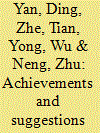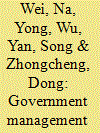|
|
|
Sort Order |
|
|
|
Items / Page
|
|
|
|
|
|
|
| Srl | Item |
| 1 |
ID:
109311


|
|
|
|
|
| Publication |
2011.
|
| Summary/Abstract |
In order to promote energy efficiency and emission reduction, the importance of improving building energy efficiency received sufficient attention from Chinese Government. The heat metering and energy efficiency retrofit for existing residential buildings of 0.15 billion m2 in northern heating regions of China was initiated in 2007 and completed successfully at the end of 2010. This article introduced the background and outline of the retrofit project during the period of 11th five-year plan. Numerous achievements that received by retrofit such as environmental protection effect, improvement of indoor environment, improvement of heating system, investment guidance effect, promotion of relevant industries and increasing chances of employment were concluded. Valuable experience that acquired from the retrofit project during the period of 11th five-year plan was also summarized in this article. By analyzing the main problems emerged in the past, pertinent suggestions were put forward to promote a larger scale and more efficient retrofit project in the period of 12th five-year plan.
|
|
|
|
|
|
|
|
|
|
|
|
|
|
|
|
| 2 |
ID:
088197


|
|
|
|
|
| Publication |
2009.
|
| Summary/Abstract |
Buildings are important contributors to total energy consumption accounting for around 30% of all energy consumed in China. Of this, around two-fifths are consumed within urban homes, one-fifth within public buildings, and two-fifths within rural area. Government office buildings and large-scale public buildings are the dominant energy consumers in cities but their consumption can be largely cut back through improving efficiency. At present, energy management in the large public sector is a particular priority in China. Firstly, this paper discusses how the large public building is defined, and then energy performance in large public buildings is studied. The paper also describes barriers to improving energy efficiency of large public buildings in China and examines the energy-efficiency policies and programs adopted in United States and European Union. The energy-efficiency supervision (EES) systems developed to improve operation and maintenance practices and promote energy efficiency in large public sector are described. The benefits of the EES systems are finally summarized.
|
|
|
|
|
|
|
|
|
|
|
|
|
|
|
|
| 3 |
ID:
088201


|
|
|
|
|
| Publication |
2009.
|
| Summary/Abstract |
The supervision of energy efficiency in government office buildings and large-scale public buildings (GOBLPB) is the main embodiment for government implementation of Public Administration in the fields of resource saving and environmental protection. It is significant for China government to achieve the target: reducing building energy consumption by 11 million ton standard coal before 2010. In the framework of a national demonstration project concerning the energy management system, Shenzhen Municipality has been selected for the implementation of the system. A data acquisition system and a methodology concerning the energy consumption of the GOBLPB have been developed. This paper summarizes the various features of the system incorporated into identifying the building consumes and energy saving potential. This paper also defines the methods to achieve the real-time monitoring and diagnosis: the meters installed at each building, the data transmitted through internet to a center server, the analysis and unification at the center server and the publication through web. Furthermore, this paper introduces the plans to implement the system and to extend countrywide. Finally, this paper presents some measurements to achieve a common benefit community in implementation of building energy efficiency supervisory system on GOBLPB in its construction, reconstruction or operation stages.
|
|
|
|
|
|
|
|
|
|
|
|
|
|
|
|
| 4 |
ID:
088204


|
|
|
|
|
| Publication |
2009.
|
| Summary/Abstract |
In China, Energy Efficiency Retrofit for Existing Residential Buildings (EERFERB) is faced with a fast development status. The Central Government decided to prompt the retrofit of 1.5×108 m2 existing residential buildings in China's northern heating region during the "11th Five-Years Plan". But, at present, the relative incentive policies and measurements are very insufficient. Especially, on the aspect of the retrofit pattern about the organization, retrofit content, investing and financing mode, the policy and management and other factors, no existing successful one can be spreaded into the whole northern heating region. This research not only analyzed the foreign advanced methods, drew lessons from their retrofit in Germany and Poland, but contrasted and analyzed energy efficiency retrofit demonstrations from Harbin, Tianjin, Tangshan and Baotou in China to get our domestic successful patterns and experience. Finally, some recommended retrofit patterns are presented, which can be applied for the instruction and decision-making for the Chinese local governments.
|
|
|
|
|
|
|
|
|
|
|
|
|
|
|
|
| 5 |
ID:
088203


|
|
|
|
|
| Publication |
2009.
|
| Summary/Abstract |
According to the "Comprehensive Work Program of Energy Efficiency and Emission Reduction" of the Chinese government, during the period of the "11th Five-Year Plan", 1.5×108 m2 of existing residential buildings in China's northern heating region are to be retrofitted for energy efficiency. However, at present, this "Energy Efficiency Retrofit for Existing Residential Buildings" (EERFERB) faces many obstacles. Under the current working and market system, both the central and local governments and the energy supply companies can not push on this work smoothly. Using both the results of the annual national special inspection of building energy efficiency and some case analyses, this paper examines the necessity for energy efficiency retrofit, along with the relationships among the various Political, Economic, Social, Technological, Environmental and Legal (PESTEL) factors affecting it. Furthermore, organizational, financial and technical support systems are explored to promote the development of retrofit. Finally, some primary principles to be followed toward the implementation of EERFERB are suggested.
|
|
|
|
|
|
|
|
|
|
|
|
|
|
|
|
|
|
|
|
|